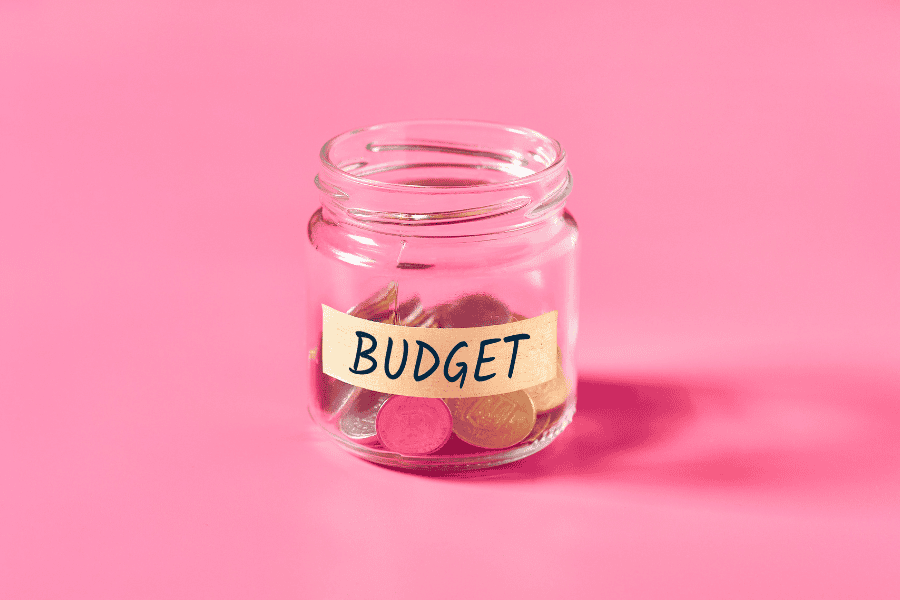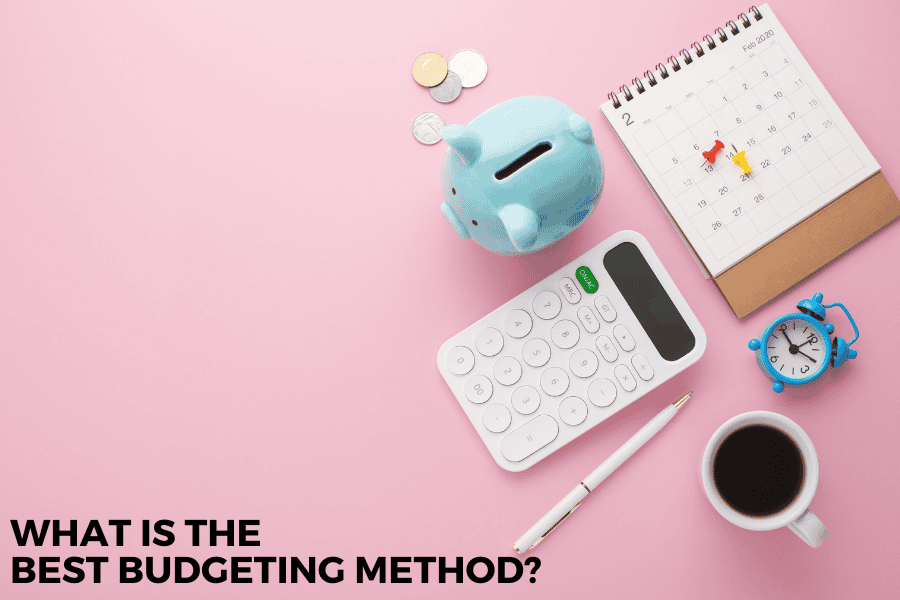Last Updated September 15, 2024 by Davina Kelly
Do you want to learn the best budgeting methods?
You’re probably reading this because you want to take control of your finances.
Maybe you’ve finally decided that this year you’ll start budgeting. Or maybe you’ve tried budgeting before but it felt too overwhelming.
Either way, you’re in the right place. Budgeting doesn’t have to be complicated or restrictive. The best budgeting methods for beginners are those that fit seamlessly into your life.
It should help you manage your money, save more and reach your financial goals.
Having the right budget in place has been a game-changer for me. It’s helped me pay off debt, save for a property down payment and even start building an investment portfolio.
In this post, I’ll guide you through the best budgeting methods for beginners. I will explain how each budget works along with the pros and cons.
After reading this post, you’ll have the tools you need to start saving, building wealth and making your money work for you.
Here are the best budgeting methods
- 50/30/20 Rule
- Zero-Based Budget
- Envelope Budgeting Method
- Pay Yourself First Method
- Line-Item Budgeting
- Percentage Budgeting
- The “No Budget” Budget
Now, let’s dive into each budgeting method and find out which one might be your perfect match.
This post may contain affiliate links, which means we will receive a commission if you purchase through our links, at no extra cost to you. Please read full disclosure for more information.
The Best Budgeting Methods For Beginners:
1. The 50 30 20 Rule
What It Is
The 50/30/20 Rule is a super simple budgeting method that breaks down your income into three main categories. It’s the budget you probably hear talked about the most.
It was popularised by U.S. Sen. Elizabeth Warren in her book All Your Worth: The Ultimate Lifetime Money Plan.
How It Works
50% goes to Needs: This includes essential expenses like rent or mortgage, groceries, utilities and transportation. These are things you need to pay for each month to maintain your living standards.
30% goes to Wants: This is your fun money for things like dining out, entertainment, shopping or hobbies. Basically, anything that isn’t essential but adds joy to your life.
20% goes to Savings or Debt Repayment: This portion goes toward building your savings, whether it’s for an emergency fund or retirement. Or it can go towards paying off debt.
It’s worth noting that this method was suggested back in 2006 when we were in a much different economic climate. So, it might need adjusting.
Personally, I would suggest allocating 30% to savings or debt repayment and 20% to wants. To me, building a financial cushion and paying off debt, especially high-interest debt, is a higher priority than spending on non-essentials.
Read here to learn more about the 50/30/20 budget and how to set it up step by step.
Who It’s Best For
If you’re new to budgeting or want something easy to stick with, the 50/30/20 rule is a good choice. It’s also perfect if you want a straightforward approach to managing your money without having to get too deep into the details.
Pros:
- Easy to understand and implement.
- Provides a balanced approach to spending and saving.
- Flexible enough to adjust slightly based on your needs.
Cons:
- The 50/30.20 split might not work for everyone, especially if you have high living costs or a lot of debt.
- It doesn’t get into the details of your spending, so it might not be detailed enough if you want more control over your finances.
2. Zero-Based Budgeting
What It Is
Zero-based budgeting is a method where you give every dollar a job. This means by the end of the month, your income minus your expenses should equal zero. Every single dollar you earn is allocated to a specific category such as bills, savings or spending.
How It Works
Here is an example of a zero-based budget below:
Income:
Corporate job – $3,500
Side hustle – $1,000
Total monthly income = $4,500
Expenses:
Housing – $2,000
Utilities – $300
Transport – $100
Savings – $800
Debt payments – $500
Groceries – $400
Eating out – $200
Theatre – $150
Miscellaneous – $50
Total monthly expenses = $4,500
Ensure that you list all your expenses as accurately as possible and allocate the amounts based on your priorities.
For example, if you’re saving for a new car and have low-interest debt you can allocate more to your savings. But if you have high-interest debt you may want to prioritise paying that off and saving a little less for now.
If you have any money left over, decide where it should go – either savings, investing or debt repayment.
Also, track your spending throughout the month and make any adjustments as needed.
Who It’s Best For
Zero-based budgeting is ideal for people who want to have control over their finances. If you’re used to budgeting and like to know exactly where your money is going, this method could be a good fit.
Pros:
- Provides a high level of control and awareness over your spending.
- Helps prevent overspending by making you intentional with your money.
- It’s a good option if you have irregular income as it forces you to plan carefully.
Cons:
- Can be time-consuming to maintain, especially if you have a lot of expenses.
- It requires consistent tracking and adjustment, which can feel overwhelming for beginners.
Grab your FREE printable budget tracker below and start building your budget.
3. Envelope Budgeting Method
What It Is
The envelope budgeting method is a cash-based system where you allocate your money into envelopes for different categories. Once the cash in the envelope is gone, you can’t spend any more in that category until the next month.
How It Works
Here’s how to use the envelope budgeting method:
Decide on your categories: Make a list of your budget categories. If you have a lot you can prioritise the main categories and the areas you tend to overspend. For example, you can focus on groceries, savings, eating out and entertainment.
Allocate money: Withdraw cash and divide it into the appropriate envelopes. For example, if your grocery budget is $300 for the month, put $300 in your grocery envelope.
Spend from the envelopes: When you need to buy something, take the money from the corresponding envelope. When it’s empty, that’s it. You’re done spending in that category until next month.
Who It’s Best For
This method is great for people who struggle with overspending and need a visual, tangible way to stick to their budget. It’s also good if you prefer using cash and want to avoid relying on credit or debit cards.
If you want to try this budgeting method, you can buy some affordable budget envelopes like these. Then, start organising your budget.
Pros:
- Highly effective for controlling variable expenses.
- Forces you to be mindful of your spending and live within your means.
- It doesn’t require a complex tracking system – just use your envelopes.
Cons:
- It can be inconvenient in a cashless world where many transactions are done electronically.
- Carrying cash can be risky (e.g. you could lose an envelope) and impractical for fixed expenses like rent.
4. Pay Yourself First Method
What It Is
The pay-yourself-first method is all about prioritising savings and investments before you spend any of your income on other expenses. The idea is to treat your savings like non-negotiable bills that you pay first, which ensures you’re constantly building wealth.
This is one of the budgeting methods I personally use. It helped me save for a property down payment and build a five-figure investment portfolio.
How It Works
Here’s how to set it up
Decide on an amount to save: Determine a percentage or fixed amount of your income to save each month.
Automate your savings: Set up automatic transfers from your checking account to your savings account. This should be done on payday so that the money is saved before you even have a chance to spend it.
Live on the rest: After paying yourself first use the remaining income for your bills, needs and wants.
Who It’s Best For
This method is ideal for those struggling to save money and need to make it a top priority. If you’ve found that you tend to spend first and save whatever’s left, this approach can help you reverse that habit.
Pros:
- Helps to build savings quickly and consistently.
- Removes the temptation to spend money that should be saved.
- It’s great for achieving long-term financial goals like retirement or buying a home.
Cons:
- Requires discipline to manage the remaining budget after savings.
- It can feel restrictive if your budget is already tight.
5. Line Item Budgeting
What It Is
Line-item budgeting is a traditional method where you detail every single expense category. This method gives you a clear picture of exactly where your money is going with specific line items for everything from rent to coffee.
I combine this budgeting method with the pay-yourself-first approach and it’s been super effective. It’s helped me pinpoint where I’ve been overspending and make necessary adjustments.
For example, I used to spend a lot of money on eating out and takeaways. However, once I implemented this budget, I was able to cut back and allocate the extra money to savings.
How It Works
List all your categories: Break down your spending into as many categories as necessary. For example, instead of having a “food” category, you can have separate categories for groceries, eating out and takeaways.
Set limits for each category: Based on your income, decide how much money you want to allocate to each category.
Track your spending: Throughout each month, record your expenses and make sure you’re staying within your limit for each category.
Who It’s Best For
If you prefer to have detailed control over your finances and enjoy tracking every penny, this is one of the best budgeting methods. It’s also a good option if you want to identify specific areas where you might be overspending.
Pros:
- It offers granular control over your spending.
- Helps you identify spending patterns and areas where you can cut back.
- It’s ideal if you enjoy detailed record-keeping.
Cons:
- It can be time-consuming and overwhelming, especially for beginners.
- It may put you off budgeting if the tracking becomes too tedious.

6. Percentage-Based Budgeting
What It Is
Percentage-based budgeting involves allocating specific percentages of your income to different categories. It’s similar to the 50/30/20 rule but can be customised to fit your unique financial situation.
For example, you might choose the 60/30/10 or 70/20/10 split depending on your goals.
Related: The 60 30 10 Budget Rule Explained
How It Works
Here’s how to set it up
Decide on your percentages: Based on your financial goals, determine how much of your income you want to allocate to needs, wants and savings. For example, a 60/30/20 split might allocate 60% to savings, 30% to needs and 20% to wants.
Apply the percentages: Multiply your income by the chosen percentages to determine how much you’ll allocate to each category.
Track your spending: Monitor your spending to ensure you’re sticking to your allocated percentages throughout the month.
Who It’s Best For
This is the best budgeting method for people who prefer a structured yet flexible approach. It’s also ideal if you have specific financial goals and want to customise your budget to meet those targets
Pros:
- It’s adaptable to different income levels and financial goals.
- Provides structure without being overly rigid.
- It’s easier to adjust than a detailed line-item budget.
Cons:
- Requires careful monitoring.
- Might not be detailed enough for those who need more control over their spending.
7. The “No Budget” Budget
What It Is
The “No Budget” budget is as it sounds, it’s about not having a budget at all. This actually works for some people.
Not having a budget is about a minimalist approach where you set broad spending limits rather than detailed categories. The goal is to manage your finances without worrying about the specifics.
How It Works
Here’s how you can use the “No Budget” Budget:
- Set a savings goals: Decide how much you want to save each month and automate that savings.
- Pay your bills and spend the rest: As long as you’ve paid your bills and met your savings goals, you can spend the rest as you see fit.
Who It’s Best For
This method is perfect for those who find traditional budgeting too restrictive and prefer a more relaxed approach. If you’re disciplined enough to save first and manage the rest, this method can be freeing and easy to maintain.
Pros:
- It’s simple and stress-free with minimal tracking.
- Allows for flexibility and spontaneous spending.
- It’s a great option if you dislike the constraints of traditional budgets.
Cons:
- Requires strong discipline to meet savings goals without overspending.
- It may not be detailed enough for those with specific financial goals or debts.
How To Choose The Right Budgeting Method For You
Now that we’ve explored some of the best budgeting methods for beginners, the next step is figuring out which one is right for you. Here is how you can narrow it down.
Match Your Budget To Your Financial Goals
Your financial goals should be the primary driver behind your choice of budgeting method. If your goal is to pay off debt, a method like zero-based budgeting or the 50/30/20 can help you prioritise debt repayment.
Is building savings your main focus? Then the pay-yourself-first method is probably the best option,
If you struggle with discipline and need help managing your variable expenses, the envelope budgeting method can help keep you on track.
On the other hand, if your goal is to improve your finances with a bit of flexibility, percentage-based budgeting or the “no budget” budget might be a better fit.
Adapt Your Budget Method To Your Personality
Let’s be honest, your personality matters when it comes to budgeting. Are you someone who loves details and control? Then zero-based or line-item budgeting might be for you.
However, if you prefer a more laid-back approach, percentage-based budgeting or the “No Budget” budget could be a better fit.
Think about your habits and how you interact with money. Do you need a system that keeps you accountable like envelope budgeting? Or do you thrive on the freedom that comes with less structured methods?
Combine Budget Methods
Sometimes, the best solution is a combination of methods. This has worked really well for me. By combining the pay-yourself-first method with line-item budgeting, I was able to reach my financial goals.
You might find that using the 50/30/20 rule for your overall budget, paired with envelope budgeting for specific categories like groceries and eating out works perfectly for you.
The key is to stay flexible and adapt as your financial situation changes. There’s no one size fits all solution and it’s ok to adjust your approach until you find what works best for you.
Final Thoughts about The Best Budgeting Methods
Budgeting doesn’t have to be complicated or restrictive. The best budgeting methods for beginners are those that fit your financial goals, lifestyle and personality.
Whatever your preference is there’s a method out there that can help you achieve your goals without making you feel deprived.
Remember, the goal of budgeting is to give you control over your money, not to make your life harder. So choose a method that resonates with you and start your journey toward financial freedom.
Which budget method resonates with you? Let me know in the comments below.
Other Posts You May Like:
13 Best Budgeting Tips For Beginners
15 Easy Money Management Tips For Beginners

Davina Kelly
Hey! I'm Davina, the owner of Davinas Finance Corner. I'm passionate about finding ways to budget, save, earn more money and improve your life. After breaking free from payday loan debt and living paycheck to paycheck I want to share my experience to help other women improve their finances.
